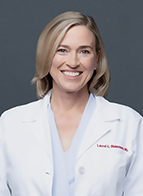Children's Scoliosis and Spine Program
Providing specialized care for children with
scoliosis, back pain and other spinal
conditions
Inova L.J. Murphy Children’s Hospital offers specialized care to
children with scoliosis, kyphosis, congenital spinal
deformities such as spina
bifida, spinal truama and other spinal conditions.
The scoliosis program provides comprehensive
evaluation, diagnosis, non-surgical and surgical
treatment for children and teens with scoliosis.
Whether your child is an infant or a young adult, we will provide comprehensive care for their spinal condition.
This program is fully integrated with Inova Neurosciences and pediatric orthopedic surgery.
Our team
At Inova L.J. Murphy Children's Hospital, our scoliosis team is led by Laurel Blakemore, MD, an internationally renowned specialist in children's spine disorders. The team includes both pediatric orthopedic surgeons and
neurosurgeons with specialized training in treating
spinal issues and deformities. When surgery is
necessary, these surgeons will often work together
in the operating room, bringing a unique treatment
approach to the treatment of scoliosis.

Laurel Blakemore, MD
The multi-disciplinary team also includes:
- Pediatric anesthesiologists
- Pediatric physical medicine and
rehabilitation physicians
- Pediatric radiologists
- Pediatric neurologists
- Pediatric critical care medicine
physicians
- Pediatric hospitalists
- Physical therapists
- Occupational therapists
- Child life specialists
- Specialists in orthotics and bracing
- Nurses
- Social workers
- Case managers
What is scoliosis?
Scoliosis is a deformity of the spine which results in a rotation or curve of the spine. The spine may look like an "s" or "c" shape, rather than a straight line. While most cases are mild, some children can experience changes that get worse as their bodies grow. Severe scoliosis can reduce the space in the chest, making it hard for the lungs to work. Scoliosis affects both girls and boys at about the same rate, but girls are at higher risk for having a curve get worse or need treatment.
The cause of most cases of scoliosis is unknown. It can occur at any age, but is common in pre-teens and adolescents. Scoliosis can also be caused by a neuromuscluar syndrome, such as muscular dystrophy, spina bifida, cerebral palsy, neurofibromitosis, or other spinal cord injuries.
Symptoms of scoliosis can include uneven shoulders and/or uneven waist, one hip sitting higher than the other or one shoulder blade that is more pronounced than the other. Mild curves often go unnoticed because they develop slowly and are not painful.
How is scoliosis diagnosed?
Your child's doctor will usually ask you questions about your child’s recent growth and take a medical history. The doctor may ask your child to stand up and bend from the waist with their arms hanging down to check if one side of the rib cage is more prominent.
X-rays can generally determine if a child has scoliosis, and if so, how severe a curve is. X-rays can usually be performed in a doctor’s office and do not require that patient to be sedated. Additional tests, like an MRI, may be recommended if a doctor suspects an underlying condition could be causing your child’s scoliosis.
Scoliosis treatment
Mild scoliosis cases are watched closely with physical examinations and X-Rays to monitor the curve and make sure it doesn’t get worse. In many of these cases, no treatment is needed. Some growing children will need to wear a special brace called a thoracolumbar spinal orthosis (TLSO) to stop the curve from worsening. Typically, time is allowed out of the brace for things like sports.
In more severe cases, surgery may be needed to correct a scoliosis curve. Severe cases of scoliosis can get worse as time goes on, so surgery may be an option to reduce the curve and keep it from worsening. Left untreated, curves greater than 50 degrees can continue to worsen, and potentially lead to long term health problems involving the heart/lungs. Spinal fusion surgery allows doctors to connect vertebrae together so they can’t move on their own. Small pieces of bone are then placed over the spine. Doctors will generally use hooks or screws to hold the spine straight while the bones fuse together. There are newer treatments becoming available as well such as vertebral growth modulation, which may be an option for some children. Our scoliosis specialists will discuss all of the options with you and help you choose the best treatment for your child.